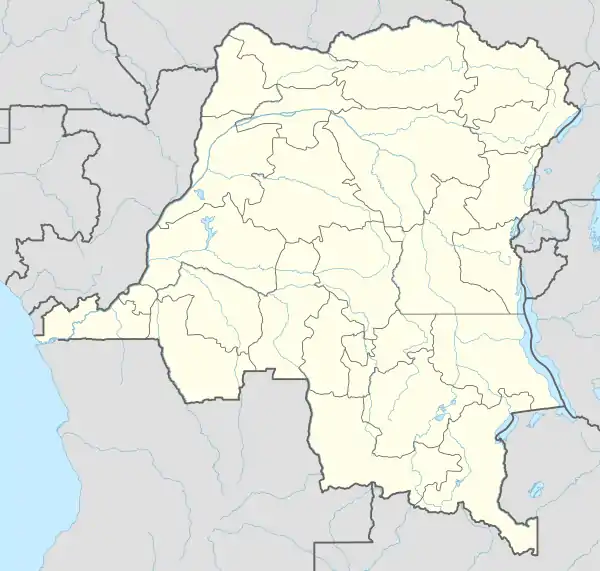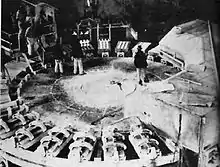Likasi
Likasi (formerly official names: Jadotville (French) and Jadotstad (Dutch)) is a city in Haut-Katanga Province, in the south-east of the Democratic Republic of Congo.
Likasi
Jadotville | |
|---|---|
City | |
| Ville de Likasi | |
 Seal | |
 Likasi Location in the Democratic Republic of the Congo | |
| Coordinates: 10°58′53″S 26°44′00″E | |
| Country | |
| Province | Haut-Katanga Province |
| Communes | Kikula, Likasi, Panda, Shituru |
| Government | |
| • Mayor | Idesbald Petwe Kapande |
| Area | |
| • City | 245 km2 (95 sq mi) |
| Elevation | 1,318 m (4,324 ft) |
| Population (2015)[2] | |
| • City | 635,463 |
| • Density | 2,600/km2 (6,700/sq mi) |
| • Urban | 495,000 |
| Time zone | UTC+2 (Central Africa Time) |
| Climate | Cwa |
Demographics

Likasi has a population of around 635,000 (2015).[2] During the 1990s the United Nations set up feeding centres and refugee centres in and around Likasi to assist with the refugees fleeing ethnic violence in Shaba,[4] whose arrival had increased the population of the town some 41,000.[5]
History

Shinkolobwe mine, 20 km west of Likasi (then called Jadotville), was described by a 1943 Manhattan Project intelligence report as the most important deposit of uranium yet discovered in the world. The uranium from this mine was used to build the atomic bombs used in Hiroshima and Nagasaki in 1945. In 1961, during the United Nations intervention in the Katanga conflict, a company of Irish UN troops deployed to Jadotville was besieged and eventually surrendered to troops loyal to the Katangese Prime Minister Moise Tshombe.
Economy

Likasi remains a centre for industry, especially mining,[6] and is a transport hub for the surrounding region. There are mines and refineries supplied by nearby deposits of copper and cobalt.[7] There is also an abandoned gold mine in Likasi, which has been commercially depleted but is still dug by artisanal miners.
Transport
Likasi is served by a station on the national railway system. The trains are mostly cargo trains and not passenger trains.
Climate
Likasi has a humid subtropical climate (Köppen: Cwa).
| Climate data for Likasi | |||||||||||||
|---|---|---|---|---|---|---|---|---|---|---|---|---|---|
| Month | Jan | Feb | Mar | Apr | May | Jun | Jul | Aug | Sep | Oct | Nov | Dec | Year |
| Daily mean °C (°F) | 21.4 (70.5) |
21.5 (70.7) |
21.5 (70.7) |
20.9 (69.6) |
18.6 (65.5) |
16.2 (61.2) |
15.9 (60.6) |
18.1 (64.6) |
21.3 (70.3) |
22.8 (73.0) |
22.3 (72.1) |
21.7 (71.1) |
20.2 (68.4) |
| Average precipitation mm (inches) | 212 (8.3) |
205 (8.1) |
214 (8.4) |
62 (2.4) |
6 (0.2) |
0 (0) |
0 (0) |
0 (0) |
8 (0.3) |
65 (2.6) |
177 (7.0) |
226 (8.9) |
1,175 (46.2) |
| Source: Climate-Data.org[8] | |||||||||||||
Notes
- Tshibanda, Alain. "Vol des cables et cornières de la SNEL au Haut-Katanga, la mairie de Likasi s'active". TopCongoFM.net (in French) (2 August 2019). Archived from the original on 2 September 2019. Retrieved 2 September 2019.
- caid.cd/index.php/donnees-par-villes/ville-de-likasi/?domaine=fiche
- PopulationStat.com
- ACC/SCN Secretariat with Shoham, Jeremy (8 December 1993) "Current Situation: 11. Shaba Region, Zaire" Archived 2011-05-24 at the Wayback Machine Refugee Nutrition Information System (RNIS), No. 2 - Report on the Nutrition Situation of Refugee and Displaced Populations United Nations Administrative Committee on Coordination, Sub-committee on Nutrition, Geneva
- ACC/SCN Secretariat with Shoham, Jeremy (17 October 1994) "Current Situation: 11. Shaba/Kasai Regions, Zaire" Archived 2011-05-24 at the Wayback Machine Refugee Nutrition Information System (RNIS), No. 7 - Report on the Nutrition Situation of Refugee and Displaced Populations United Nations Administrative Committee on Coordination, Sub-committee on Nutrition, Geneva
- Harding, Andrew (27 March 2009)"Slowdown blights DR Congo economy" BBC News, accessed 27 March 2009
- Rorison, Sean (2008) "Likasi" Congo: Democratic Republic and Republic Bradt Travel Guides, Chalfont St. Peter, England, pp. 143-145 ISBN 1-84162-233-8
- "Climate:Likasi". Climate-Data.org. Retrieved 10 April 2014.